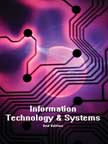Information Technology & Systems
 |
Details
Textbook Edition: II
Pages : 490;
Paperback;
210 X 275 mm approx.
Detail Table of Contents
Workbook Edition: II
Pages : 231; Paperback;
210 X 275 mm approx.
Pricing
Textbook Price: Rs. 900;
Workbook Price: Rs. 700;
Available only in INDIA
Basics of E-Business and Enterprise Application Integration : Chapter 16
SUMMARY: The first phase of e-business evolution focused on transaction-oriented e-commerce while with the evolution of the second phase, companies shifted their focus toward customer-centric e-business. Information is the key for conducting e-business and in the e-business environment the intermediaries are bypassed and replaced by websites called infomediaries. In e-business, organizations need to continuously make efforts to enhance and leverage their business processes and technology to achieve the highest degree of customer satisfaction and organizational culture plays an important role in maintaining this focus. E-Business models include business-to-business (B2B), business-to-consumer (B2C), consumer-to-consumer (C2C), business-to-employee (B2E), government-to-citizen (G2C), citizen-to-government (C2G), government-to-government (G2G), and government-to-business (G2B). |
|
EAI should not be considered as a destination, but rather as a journey. Increasingly, complex business processes are being automated, standardized, reused, and shared.
|
These will lead to the attainment of higher business value. But the costs associated with the implementation of EAI must also be taken into consideration as they can be substantial, both from a financial point of view and in terms of the organizational disruptions that are often involved. |
EAI implementation leads to a considerable augmentation in productivity by cutting down cycle times for improvement and freeing resources to support further integration efforts. The flexibility of EAI allows for changes to the business and technical landscape to occur with minimal rework and effect on production systems. Increased manageability and maintainability provides extended technical control of the environment for proactive and reactive management of systems.
Related Books:-
 Case Studies in IT and Systems
Case Studies in IT and Systems
263 pages, Paperback
Available only in INDIA

